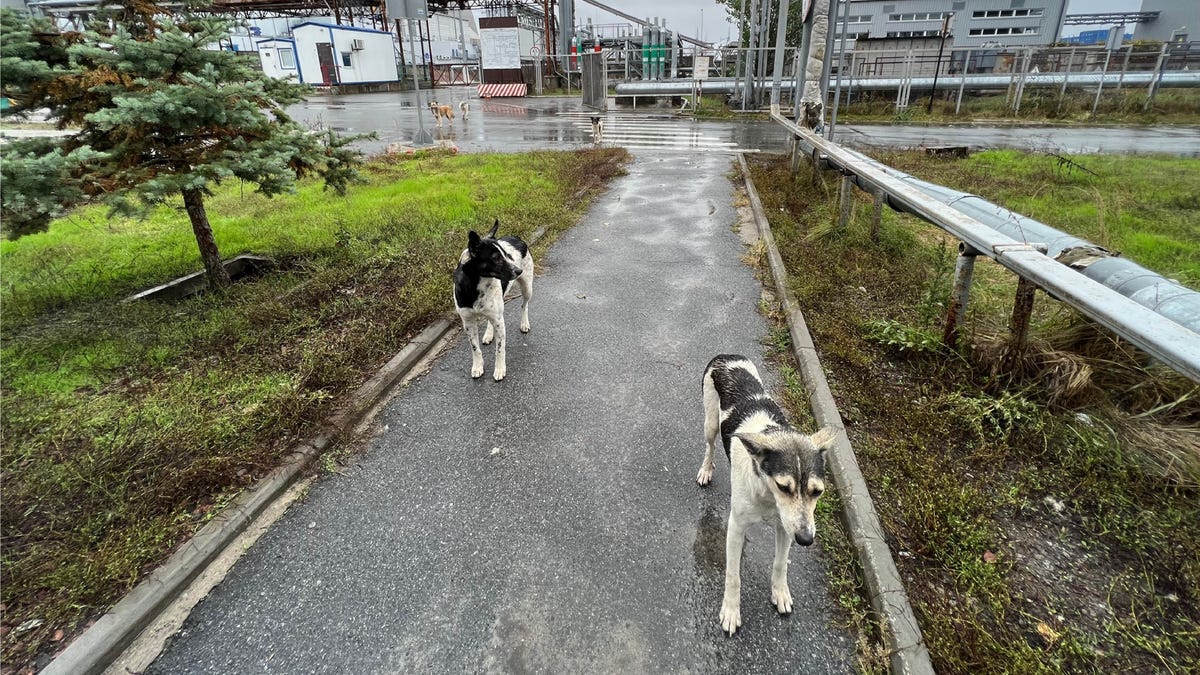In the Shadow of Chernobyl, a Pack of Dogs Unlike Any Other Roams the Wasteland
In 1986, reactor number four at the Chernobyl Nuclear Power Plant in Ukraine suffered a catastrophic meltdown. An assault of radioactive atoms burst forth from the wreckage and dispersed across Europe, even reaching as far as North America. In the area surrounding the power plant, an ecological disaster began to unfold. Pine trees crumbled. Insect populations plummeted. Polluted soil withered crops.
In the hours following the meltdown, residents of nearby neighborhoods were forced to up and leave with little notice while the liquidators — military personnel and other civilians — moved in to “clean up” the radioactive mess. Pets were not permitted to travel with the evacuees and had to be abandoned. A directive by the Ukraine Ministry of Internal Affairs tasked military personnel with hunting down and executing the pets, including the many dogs of the region inside the Chernobyl Exclusion Zone.
But some of the pets evaded capture and killing, making a home in the CEZ. The liquidators would often feed and house the now-strays, and the populations persevered.
Today, Chernobyl’s doomed reactor is entombed within a massive concrete structure known as the sarcophagus, but the effects of its meltdown linger. The radioactive atoms — radionuclides — released in the 10 days after the catastrophe still permeate the soil, the water and, yes, the animals that have made the CEZ their home, including Chernobyl’s dogs.
This unfortunate fate for the canines has a somewhat grim silver lining. By studying the DNA of these dogs, researchers could better understand how chronic exposure to radiation leaves long-lasting effects on physiology and health.
In a new study, published in the journal Science Advances on March 3, researchers set out to decode the genetics of the canine population around Chernobyl, characterizing the genes of 302 free-roaming dogs that now call the power plant and surrounding region home. It’s the first time a large mammal in the CEZ has been studied in this way.
“They offer a chance to see how the harsh environment, which includes exposure to high and low levels of radiation, can affect the DNA of animals who have lived and bred for 15 generations in this region,” said Elaine Ostrander, a geneticist at the National Human Genome Research Institute of the National Institutes of Health and author on the study.
By studying tiny changes in the DNA known as SNPs, the team were able to measure genetic similarity in these populations. Comparing Chernobyl’s dogs to pure-bred canines from elsewhere in Europe, the team revealed that one group of canines living close to the Chernobyl Nuclear Power Plant, occupying Pripyat and the nearby train station, is a genetically distinct and closed family.
This group differed, genetically, from dogs living just 10 miles away, in Chernobyl city, which appear to have migrated more and bred with local dogs.
“This sets the stage for future studies aimed at finding mutations in key genes that result from the radioactive environment,” said Ostrander.
Importantly, the study doesn’t show that radiation in the disaster zone has, itself, caused changes or mutations in the dogs’ DNA. Inbreeding and isolation can cause the kind of changes the team has seen in the DNA.
“To tell if there were de novo radiation-caused mutations, the researchers would have needed to conduct whole genome sequencing of the dogs and see if there were any unique variants in this population,” said Claire Wade, an animal geneticist and computational biologist at the University of Sydney not associated with the study.
A de novo mutation is one that wasn’t passed down genetically. By looking at a whole genome — all of an organism’s DNA — rather than just SNPs, researchers can tease out more information, discovering mutations in genes that may have physiological effects. That’s exactly what the Chernobyl dog team plans to do.
With more than 400 DNA samples now collected, the researchers can begin to interrogate how DNA variation in these Chernobyl populations might help the dogs live in a highly radioactive environment. Perhaps, for instance, there are certain genes that have been switched on or off that confer a survival advantage in dogs closer to the plant. Comparing the whole genome sequences will help uncover these relationships.
At present, a full DNA sequence has been retrieved for over half of the 400 samples, noted Tim Mousseau, a biologist at the University of South Carolina who has long studied the organisms around Chernobyl following the disaster and an author on the paper.
A myth has persisted that life has returned and flourished in Chernobyl post-disaster, but that’s not necessarily the case. Though the dogs are the first large mammal to be studied in Chernobyl, previous research has explored the effects of radiation on many different organisms within the region, from insects to birds.
For instance, a 1997 paper showed that barn swallows exposed to radiation around Chernobyl had higher de novo mutations and were more likely to be partially albino, and Mousseau’s studies have shown the abundance of species has dropped in contaminated areas.
Other studies hint at the kind of revelations that might come from studying organisms in the CEZ. In 2020, scientists discovered a species of fungi with high levels of melanin, a pigment that can absorb radiation and turn it into energy. Producing high levels of melanin could provide a kind of protective sunscreen or “shield” for astronauts, where the threat of radiation is ever present.
Will the genomes of Chernobyl’s dogs provide a similar level of insight? That’s an open question the team is eager to answer.
“We really have what we need to address questions regarding the role of the environment on survival in this environment,” said Mousseau.
For all the latest world News Click Here

